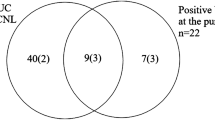Abstract
The aim of the study was to assess the preoperative and intraoperative potential risk factors for infectious complications after percutaneous nephrolithotomy (PCNL). A total of 303 patients who underwent PCNL for renal stones were included in the recent study. A detailed history including past renal surgery, nephrostomy insertion and recurrent urinary infection were obtained from all patients. Preoperative urine culture, renal pelvic urine culture and stone culture were obtained from all patients. The intraoperative data were prospectively noted. All patients were followed up postoperatively for signs of systemic inflammatory response syndrome (SIRS) and sepsis. In 83 (27.4 %) of the patients, SIRS was observed and of these patients 23 (7.6 %) were diagnosed as sepsis. Escherichia coli was the most common organism detected in cultures, followed by Pseudomonas aeruginosa, Enterococcus and Klebsiella spp. in all patients. By multivariate logistic regression analysis, presence of infection stone, stone burden and recurrent urinary tract infection were associated with both SIRS and sepsis development. Presence of infection stone, stone burden ≥800 mm2 and recurrent urinary tract infection can be identified as independent predictors for the development of SIRS and sepsis.
Similar content being viewed by others
References
Fernström I, Johansson B (1976) Percutaneous pyelolithotomy. A new extraction technique. Scand J Urol Nephrol 10:257–259
Korets R, Graversen JA, Kates M, Mues AC, Gupta M (2011) Post-percutaneous nephrolithotomy systemic inflammatory response: a prospective analysis of preoperative urine, renal pelvic urine and stone cultures. J Urol 186:1899–1903
de la Rosette J, Assimos D, Desai M, Gutierrez J, Lingeman J, Scarpa R, Tefekli A, CROES PCNL Study Group (2011) The Clinical Research Office of the Endourological Society Percutaneous Nephrolithotomy Global Study: indications, complications, and outcomes in 5803 patients. J Endourol 25:11–17
O’Keeffe NK, Mortimer AJ, Sambrook PA, Rao PN (1993) Severe sepsis following percutaneous or endoscopic procedures for urinary tract stones. Br J Urol 72:277–283
Balk RA (2000) Severe sepsis and septic shock. definitions, epidemiology and clinical manifestations. Crit Care Clin 16:179–192
Mariappan P, Smith G, Bariol SV, Moussa SA, Tolley DA (2005) Stone and pelvic urine culture and sensitivity are better than bladder urine as predictors of urosepsis following percutaneous nephrolithotomy: a prospective clinical study. J Urol 173:1610–1614
Erdil T, Bostanci Y, Ozden E, Atac F, Yakupoglu YK, Yilmaz AF, Sarikaya S (2013) Risk factors for systemic inflammatory response syndrome following percutaneous nephrolithotomy. Urolithiasis 41:395–401
Levy MM, Fink MP, Marshall JC et al (2003) 2001 SCCM/ESICM/ACCP/ATS/SIS International Sepsis Definitions Conference. Crit Care Med 31:1250–1256
Sharifi Aghdas F, Akhavizadegan H, Aryanpoor A, Inanloo H, Karbakhsh M (2006) Fever after percutaneous nephrolithotomy: contributing factors. Surg Infect (Larchmt) 7:367–371
Dogan HS, Guliyev F, Cetinkaya YS, Sofikerim M, Ozden E, Sahin A (2007) Importance of microbiological evaluation in management of infectious complications following percutaneous nephrolithotomy. Int Urol Nephrol 39:737–742
Fernandez A, Foell K, Nott L, Denstedt JD, Razvi H (2011) Percutaneous nephrolithotripsy in patients with urinary diversions: a case-control comparison of perioperative outcomes. J Endourol 25:1615–1618
Gonen M, Turan H, Ozturk B, Ozkardes H (2008) Factors affecting fever following percutaneous nephrolithotomy: a prospective clinical study. J Endourol 22:2135–2138
Gutierrez J, Smith A, Geavlete P, Shah H, Kural AR, de Sio M, Amon Sesmero JH et al (2013) Urinary tract infections and post-operative fever in percutaneous nephrolithotomy. World J Urol 31:1135–1140
Draga RO, Kok ET, Sorel MR, Bosch RJ, Lock TM (2009) Percutaneous nephrolithotomy: factors associated with fever after the first postoperative day and systemic inflammatory response syndrome. J Endourol 23:921–927
Chen L, Xu QQ, Li JX, Xiong LL, Wang XF, Huang XB (2008) Systemic inflammatory response syndrome after percutaneous nephrolithotomy: an assessment of risk factors. Int J Urol 15:1025–1028
Kumar S, Bag S, Ganesamoni R, Mandal AK, Taneja N, Singh SK (2011) Risk factors for urosepsis following percutaneous nephrolithotomy: role of 1 week of nitrofurantoin in reducing the risk of urosepsis. Urol Res 40:79–86
Wang Y, Jiang F, Wang Y, Hou Y, Zhang H, Chen Q et al (2012) Post-percutaneous nephrolithotomy septic shock and severe hemorrhage: a study of risk factors. Urol Int 88:307–310
Flannigan R, Choy WH, Chew B, Lange D (2014) Renal struvite stones-pathogenesis, microbiology and management strategies. Nat Rev Uro. doi:10.1038/nrurol.2014.99 (Epub ahead of print)
Kreydin EI, Eisner BH (2013) Risk factors for sepsis after percutaneous renal stone surgery. Nat Rev Urol 10:598–605
Zhong W, Zeng G, Wu K, Li X, Chen W, Yang H (2008) Does a smaller tract in percutaneous nephrolithotomy contribute to high renal pelvic pressure and postoperative fever. J Urol 22:2147–2151
Troxel SA, Low RK (2002) Renal intrapelvic pressure during percutaneous nephrolithotomy and its correlation with the development of postoperative fever. J Urol 168:1348–1351
Viville C, Giron JP (1998) Endoscopic and percutaneous treatment of purulent retention caused by obstructive calculi of the upper urinary tract: Observations a propos of 6 case reports. J Urol 94:317–318
Rao PN, Dube DD, Nigel CW et al (1991) Prediction of septicemia following endourological manipulation for stones in the upper urinary tract. J Urol 146:955–960
Etemadian M, Haghighi R, Madineay A, Tizeno A, Fereshtehnejad SM (2008) Delayed versus same-day percutaneous nephrolithotomy in patients with aspirated cloudy urine. Urol J 5:28–33
Hosseini MM, Basiri A, Moghaddam SM (2007) Percutaneous nephrolithotomy of patients with staghorn stone and incidental purulent fluid suggestive of infection. J Endourol 21:1429–1432
Aron M, Goel R, Gupta NP, Seth A (2005) Incidental detection of purulent fluid in kidney at percutaneous nephrolithotomy for branched renal calculi. J Endourol 19:136–139
Conflict of interest
None.
Author information
Authors and Affiliations
Corresponding author
Rights and permissions
About this article
Cite this article
Koras, O., Bozkurt, I.H., Yonguc, T. et al. Risk factors for postoperative infectious complications following percutaneous nephrolithotomy: a prospective clinical study. Urolithiasis 43, 55–60 (2015). https://doi.org/10.1007/s00240-014-0730-8
Received:
Accepted:
Published:
Issue Date:
DOI: https://doi.org/10.1007/s00240-014-0730-8




